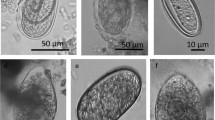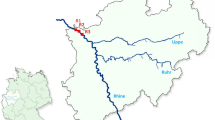Abstract
The 2 howler species that occur in southern Mexico, Alouatta palliata mexicana and Alouatta pigra are endangered, mainly as a result of habitat loss and fragmentation from human activity. Little is known about the gastrointestinal parasite communities affecting their populations, and lack of baseline information for populations of howler species in continuous forest habitats, makes evaluations of gastrointestinal parasite prevalence in populations in fragmented landscapes difficult. We report the results of a one-time broad survey of gastrointestinal parasites in fecal samples of individuals from several demographically stable populations of Alouatta palliata mexicana and A. pigra existing in continuous and/or protected forests. We further report similar data for populations of both species in human-fragmented landscapes. We detected 6 parasites for each howler monkey species, but only 3 of them (Trematode I, Controrchis biliophilus, Trypanoxyuris sp.) were common to both species. While parasitic prevalence in populations of both howler species was, in general, higher in the fragmented habitat than in continuous and/or protected forests. The difference is only marginally significant in Alouatta pigra. Some parasites (Coccidia and Strongylid) only appeared in populations in fragmented landscapes. Preliminary data suggest that adult males tended to have higher parasite prevalence values than those of adult females in both howler species. Parasite prevalence is associated to average group size, but not to population density in Alouatta pigra.





Similar content being viewed by others
References
Altizer, S., Nunn, C. L., Thrall, P. H., Gittleman, J. L., Antonovics, J., Cunningham, A. A., et al. (2003). Social organization and parasite risk in mammals: Integrating theory and empirical studies. Annu. Rev. Ecol. Evol. Syst. 34, 517–547.
Barrueta, T., Estrada, A., Pozo, C., & Calmé, S. (2003). Reconocimiento demográfico de Alouatta pigra y Ateles geoffroyi en la reserva El Tormento, Campeche, México. Neotropical Primates, 11, 165–169.
Chapman, C. A., Gillespie, T. R., & Goldberg, T. L. (2005). Primates and the ecology of their infectious diseases: How will anthropogenic change affect host-parasite interactions? Evolutionary Anthropology, 14, 134–144.
Chapman, C. A., Speirs, M. L., Gillespie, T. R., Holland, T., & Austad, K. M. (2006). Life on the Edge: Gastrointestinal parasites from the forest edge and interior primate groups. American Journal of Primatology, 68, 397–409.
Cuarón, A. D., de Grammont, P. C., Cortés-Ortíz, L., Wong, G., Silva, J. C. S., Rylands, A. B., et al. (2003). IUCN Red List of Threatened Species Assessment and Evaluation of Alouatta pigra. http://www.redlist.org/search/details.php?species = 914.
Eckert, K. A., Hahn, N. E., Genz, A., Kitchen, D. M., Stuart, M. D., Averbeck, G. A., et al. (2006). Coprological surveys of Alouatta pigra at two sites in Belize. International Journal of Primatology, 27, 227–238.
Estrada, A., Castellanos, L., Ibarra, A., Garcia Del Valle, Y., Muñoz, D., Rivera, A., et al. (2002). Survey of the population of the black howler monkey, Alouatta pigra, at the Mayan site of Palenque, Chiapas, Mexico. Primates, 44, 51–58.
Estrada, A., & Coates-Estrada, R. (1996). Tropical rain forest fragmentation and wild populations of primates at Los Tuxtlas. International Journal of Primatology, 5, 759–783.
Estrada, A., Garber, P. A., Pavelka, M., & Luecke, L. G. (2006). Overview of the Mesoamerican primate fauna, primate studies and conservation concerns: An introduction. In A. Estrada, P. A. Garber, M. S. M. Pavelka, & L. Luecke (Eds.), New perspectives in the study of Mesoamerican primates: Distribution, ecology, behavior and conservation (pp. 1–22). Berlin:Springer.
Estrada, A., Luecke, L., Van Belle, S., Barrueta, E., & Rosales-Meda, M. (2004a). Survey of black howler (Alouatta pigra) and spider (Ateles geoffroyi) monkeys in the Mayan sites of Calakmul and Yaxchilán, Mexico and Tikal, Guatemala. Primates, 45, 33–39.
Estrada, A., Van Belle, S., & García del Valle, Y. (2004b). A survey of populations of black howler (Alouatta pigra) and spider (Ateles geoffroyi) monkeys by the Lacantún River, Chiapas, Mexico. Neotropical Primates, 12, 70–75.
Ezenwa V. O. (2002). Behavioral and nutritional ecology of gastrointestinal parasitism in African bovids. Doctoral Dissertation. Princeton, NJ: Princeton University.
Freeland, W. J. (1983). Parasites and the coexistence of animal host species. American Naturalist, 2, 223–236.
Foreyt, W. J. (2001). Veterinary parasitology. NY: Blackwell Publishing.
Gillespie, T. R. (2006). Non-invasive assessment of gastro-intestinal parasite infections in free-ranging primates. International Journal of Primatology, 27, 1129–1143.
Gilliespie, T. R., & Chapman, C. A. (2006). Prediction of parasite infection dynamics in primate metapopulations based on attributes of forest fragmentation. Cons. Biol. 20, 441–448.
Gillespie, T. R., Greiner, E. C., & Chapman, C. A. (2005). Gastrointestinal parasites of the colobus monkey of Uganda. Journal of Parasitology, 91, 569–573.
Klein, S. L. (2004). Hormonal and immunological mechanisms mediating sex differences in parasite infection. Parasite Immunology, 26, 247–264.
Margolis, L., Esch, G. W., Holmes, J. C., Kuris, A. M., & Schad, G. A. (1982). The use of ecological terms in parasitology (report of an Ad Hoc Committee of the American Society of Parasitologists). Journal of Parasitology, 68, 131–133.
Michaud, C., Tantalean, M., Ique, C., Montoya, E., & Gozalo, A. (2003). A survey for helminth parasites in feral New World non-human primate populations and its comparison with parasitological data from man in the region. Journal of Medical Primatology, 32, 341–345.
Nunn, C. L., Altizer, S. M., Jones, K. E., & Sechrest, W. (2003). Comparative tests of parasite species richness in primates. American Naturalist, 162, 598–614.
Pedersen, A. B., Altizer, S., Poss, M., Cunningham, A. A., & Nunn, C. L. (2005). Patterns of host specificity and transmission among parasites of wild primates. International Journal for Parasitology, 35, 647–657.
Pérez-Ponce de León, G., & García Prieto, L. G. (2001). Los parásitos en el contexto de la biodiversidad y la conservación. Biodiversitas, 34, 11–14.
Scott, M. E. (1998). The impact of infection and disease on animal populations: Implications for conservation biology. Cons. Biol. 2, 40–56.
Shalk, G., & Forbes, M. R. (1997). Male biases in parasitism of mammals: effects of study type, host age and parasite taxon. Oikos, 78, 67–74.
Stoner, K. E. (1996). Prevalence and intensity of intestinal parasites in mantled howling monkeys (Alouatta palliata) in Northeastern Costa Rica: Implications for conservation biology. Cons. Biol. 10, 539–546.
Stoner, K., & González, A. M. (2006). Intestinal parasitic infections in Alouatta pigra in tropical rainforest in Lacandona, Chiapas, Mexico: Implications for behavioral ecology and conservation. In A. Estrada, P. A. Garber, M. Pavelka, & L. Luecke (Eds.), New perspectives in the study of mesoamerican primates. Distribution, ecology and conservation (pp. 215–240). New York: Springer.
Thompson, R. C. A. (2002). Towards a better understanding of host specificity and the transmission of Giardia: The impact of molecular techniques. In B. E. Olson, M. Olson, & P. M. Wallis (Eds.), Giardia: The cosmopolitan parasite (pp. 55–69). Wallingford, UK: CABI Publishing.
Van Belle, S., & Estrada, A. (2006). Demographic features of Alouatta pigra populations in extensive and fragmented forests. In A. Estrada, P. A. Garber, M. Pavelka, & L. Luecke (Eds.), New perspectives in the study of Mesoamerican primates. Distribution, ecology and conservation (pp. 121–142). New York: Springer.
Vitazkova, S. K., & Wade, S. E. (2006). Parasites of free-ranging black howler monkeys (Alouatta pigra) from Belize and Mexico. American Journal of Primatology, 68, 1089–1097.
Zuk, M., & McKean, K. A. (1996). Sex differences in parasite infections: Patterns and processes. International Journal for Parasitology, 26, 1009–1024.
Acknowledgements
Research supported by the Scott Neotropical Fund from the Cleveland Metroparks Zoo, Universidad Autónoma de México, National Geographic, and Universidad Autónoma Metropolitana-Xochimilco. We thank Sarie Van Belle, Yasminda García, David Muñoz, Manuel Oñorbe, Petra Wilbrink, Joseph Howes, Tana Barrueta, Lesly Alejandre and Octavio Cruz for assisting with the collection of fecal samples. We thank Araceli Lima DVS from UNAM for identification of Raillietina sp. and Trypanoxyuris sp. We are grateful to the Mexican environmental agencies, CONANP and SEMARNAT, for permission to work in the C/P forests.
Author information
Authors and Affiliations
Corresponding author
Rights and permissions
About this article
Cite this article
Trejo-Macías, G., Estrada, A. & Mosqueda Cabrera, M.Á. Survey of Helminth Parasites in Populations of Alouatta palliata mexicana and A. pigra in Continuous and in Fragmented Habitat in Southern Mexico. Int J Primatol 28, 931–945 (2007). https://doi.org/10.1007/s10764-007-9137-5
Received:
Accepted:
Published:
Issue Date:
DOI: https://doi.org/10.1007/s10764-007-9137-5




